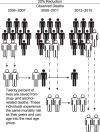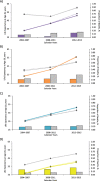Life-Expectancy Disparities Among Adults With HIV in the United States and Canada: The Impact of a Reduction in Drug- and Alcohol-Related Deaths Using the Lives Saved Simulation Model
- PMID: 31602475
- PMCID: PMC7036649
- DOI: 10.1093/aje/kwz232
Life-Expectancy Disparities Among Adults With HIV in the United States and Canada: The Impact of a Reduction in Drug- and Alcohol-Related Deaths Using the Lives Saved Simulation Model
Abstract
Improvements in life expectancy among people living with human immunodeficiency virus (PLWH) receiving antiretroviral treatment in the United States and Canada might differ among key populations. Given the difference in substance use among key populations and the current opioid epidemic, drug- and alcohol-related deaths might be contributing to the disparities in life expectancy. We sought to estimate life expectancy at age 20 years in key populations (and their comparison groups) in 3 time periods (2004-2007, 2008-2011, and 2012-2015) and the potential increase in expected life expectancy with a simulated 20% reduction in drug- and alcohol-related deaths using the novel Lives Saved Simulation model. Among 92,289 PLWH, life expectancy increased in all key populations and comparison groups from 2004-2007 to 2012-2015. Disparities in survival of approximately a decade persisted among black versus white men who have sex with men and people with (vs. without) a history of injection drug use. A 20% reduction in drug- and alcohol-related mortality would have the greatest life-expectancy benefit for black men who have sex with men, white women, and people with a history of injection drug use. Our findings suggest that preventing drug- and alcohol-related deaths among PLWH could narrow disparities in life expectancy among some key populations, but other causes of death must be addressed to further narrow the disparities.
Keywords: HIV; Hispanic adults; black women; drug- and alcohol-related deaths; health disparities; life expectancy; men who have sex with men; people who inject drugs.
© The Author(s) 2019. Published by Oxford University Press on behalf of the Johns Hopkins Bloomberg School of Public Health.
Figures



References
Publication types
MeSH terms
Grants and funding
- Z01 CP010176/ImNIH/Intramural NIH HHS/United States
- U01 AI031834/AI/NIAID NIH HHS/United States
- P30 AI094189/AI/NIAID NIH HHS/United States
- U01 AI038855/AI/NIAID NIH HHS/United States
- U54 MD007587/MD/NIMHD NIH HHS/United States
- U01 AI037613/AI/NIAID NIH HHS/United States
- UM1 AI068634/AI/NIAID NIH HHS/United States
- U01 AA020790/AA/NIAAA NIH HHS/United States
- R01 DA012568/DA/NIDA NIH HHS/United States
- UL1 TR000004/TR/NCATS NIH HHS/United States
- R01 AA016893/AA/NIAAA NIH HHS/United States
- N01 CP001004/CP/NCI NIH HHS/United States
- P30 AI027767/AI/NIAID NIH HHS/United States
- U01 AI035042/AI/NIAID NIH HHS/United States
- F31 AI124794/AI/NIAID NIH HHS/United States
- P30 MH062246/MH/NIMH NIH HHS/United States
- U01 AI069434/AI/NIAID NIH HHS/United States
- U01 AI037984/AI/NIAID NIH HHS/United States
- U01 AI103397/AI/NIAID NIH HHS/United States
- Z01 CP010121/ImNIH/Intramural NIH HHS/United States
- R01 DA011602/DA/NIDA NIH HHS/United States
- K23 EY013707/EY/NEI NIH HHS/United States
- R01 CA165937/CA/NCI NIH HHS/United States
- UL1 TR001863/TR/NCATS NIH HHS/United States
- U01 AI035004/AI/NIAID NIH HHS/United States
- G12 MD007583/MD/NIMHD NIH HHS/United States
- K24 DA000432/DA/NIDA NIH HHS/United States
- U01 DA036935/DA/NIDA NIH HHS/United States
- UL1 RR024131/RR/NCRR NIH HHS/United States
- U01 AI034989/AI/NIAID NIH HHS/United States
- U01 AI035041/AI/NIAID NIH HHS/United States
- R24 AI067039/AI/NIAID NIH HHS/United States
- U01 DA036297/DA/NIDA NIH HHS/United States
- UM1 AI035043/AI/NIAID NIH HHS/United States
- U01 AI069432/AI/NIAID NIH HHS/United States
- U01 AI038858/AI/NIAID NIH HHS/United States
- U10 EY008057/EY/NEI NIH HHS/United States
- U01 AI068636/AI/NIAID NIH HHS/United States
- U01 AI034994/AI/NIAID NIH HHS/United States
- M01 RR000052/RR/NCRR NIH HHS/United States
- UL1 TR000454/TR/NCATS NIH HHS/United States
- U10 EY008052/EY/NEI NIH HHS/United States
- P30 AI110527/AI/NIAID NIH HHS/United States
- P30 AI027763/AI/NIAID NIH HHS/United States
- K01 AI093197/AI/NIAID NIH HHS/United States
- U01 AI069918/AI/NIAID NIH HHS/United States
- K24 AI118591/AI/NIAID NIH HHS/United States
- K24 AI065298/AI/NIAID NIH HHS/United States
- U01 AI103401/AI/NIAID NIH HHS/United States
- U01 AA013566/AA/NIAAA NIH HHS/United States
- N02 CP055504/CP/NCI NIH HHS/United States
- KL2 TR002317/TR/NCATS NIH HHS/United States
- UL1 TR000083/TR/NCATS NIH HHS/United States
- P30 AI027757/AI/NIAID NIH HHS/United States
- KL2 TR000421/TR/NCATS NIH HHS/United States
- U01 AI035040/AI/NIAID NIH HHS/United States
- K01 AI131895/AI/NIAID NIH HHS/United States
- U01 AI103390/AI/NIAID NIH HHS/United States
- U01 AI034993/AI/NIAID NIH HHS/United States
- U01 AI103408/AI/NIAID NIH HHS/United States
- F31 DA037788/DA/NIDA NIH HHS/United States
- U01 AI035039/AI/NIAID NIH HHS/United States
- R01 AG053100/AG/NIA NIH HHS/United States
- U10 EY008067/EY/NEI NIH HHS/United States
- P30 AI036219/AI/NIAID NIH HHS/United States
- U24 AA020794/AA/NIAAA NIH HHS/United States
- U01 AI068634/AI/NIAID NIH HHS/United States
- P30 AI050410/AI/NIAID NIH HHS/United States
- U01 HD032632/HD/NICHD NIH HHS/United States
- U01 AI042590/AI/NIAID NIH HHS/United States

